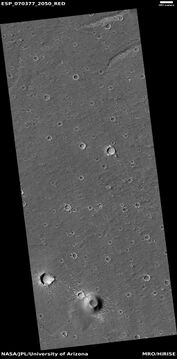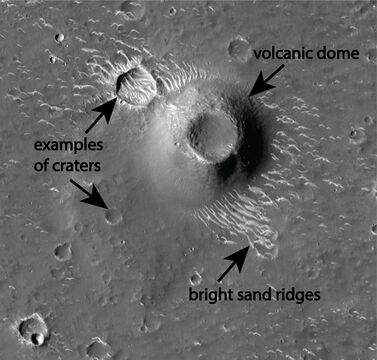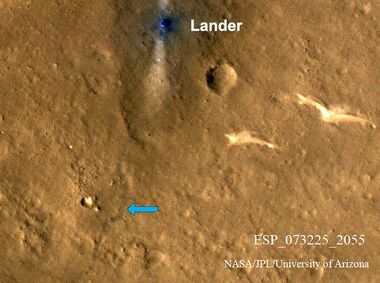Zhurong
Zhurong is a six-wheeled rover built by China. It landed on Mars in the area called Utopia Planitia on May 14, 2021. Zhurong is about the size of NASA's twin Mars rovers Spirit and Opportunity. It has six scientific instruments, including two panoramic cameras, a ground-penetrating radar and a magnetic field detector. Like America's Curiosity and Perseverance Martian rovers, Zhurong has a laser to zap rocks and thereby study their compositions.[1]
Summary
Research published in May, 2022 described chemical evidence for water discovered by the Zhurong Rover. Hydrated sulfate/silica materials were identified on the Amazonian-age terrain at the landing site. These hydrated minerals were found in bright-toned rocks. Authors of the research interpreted these minerals to be from a "duricrust." The duricrust was formed either by groundwater rising or subsurface ice melting. This duricrust was created just under the surface,and then was uncovered by erosion.
Finding these minerals here suggests that water may have been present at later times then thought. Perhaps liquid water appeared after impacts or from hot magma under the surface. We know there is much ice under the surface and any heat might melt it, and then the water could carry dissolved minerals around. The minerals could then be deposited when water evaporated.[2] [3]
China's Zhurong rover that has studied the Utopia Planitia region of Mars has found dunes that lie in different directions. That different set of directions means that the wind direction made about a 70 degree change in direction. The researchers found that the dunes were formed when the tilt changed and caused a shift in the winds. At about the same time, layers in the Martian northern ice caps show a change.[4]
Examination of the fine layers of rocks by Zhurong rover, led researchers to interpret them as sedimentary structures typical of formation in a marine environment. This is evidence for the hypothesis for an ocean in the Hesperian period. The rocks were from the Vastitas Borealis Formation (VBF).[5] [6]
A large team of researchers announced the discovery of beaches near Zhurong. Radar on the rover found beds that slope the same amount as beds on the Earth. These beaches support the idea of a large ocean on the north end of the planet.[7] [8]
Technical Innovations
Under two circular windows are ten containers which hold N-undecane (a chemical used as a sex pheromone by cockroaches and moths), which will melt in the Martian day time, and freeze at night. This chemical has a high heat of fusion, so it will release a fair amount of heat just when the Martian night is getting coldest. It was hoped that this would prolong the life of the Rover by keeping batteries and key electronics warmer at night.[9]
End of Mission
Solar cells have a short life on Mars (due to dust build up), and as of late February, 2023, the Zhurong rover has been immobile for months. It should have woken up last month. Zhurong had anti dust coatings on its solar cells, but moving dust on Mars builds up static charges which cause them to stick to surfaces strongly. China has not announced the end of the mission, so perhaps the engineers hope that the rover may still recover.[10]
References
- ↑ https://www.space.com/china-mars-rover-landing-success-tianwen-1-zhurong
- ↑ https://www.science.org/doi/10.1126/sciadv.abn8555
- ↑ Liu, Y., et al. 2022. Zhurong reveals recent aqueous activities in Utopia Planitia, Mars. Science Advances. VOL. 8, NO. 19
- ↑ Liu, J., et al. 2023. Martian dunes indicative of wind regime shift in line with end of ice age. Nature
- ↑ https://academic.oup.com/nsr/article/10/9/nwad137/7160482
- ↑ Xiano, L., et al. 2023. https://academic.oup.com/nsr/article/10/9/nwad137/7160482. National Science Review, Volume 10, Issue 9, September 2023, nwad137, https://doi.org/10.1093/nsr/nwad137
- ↑ Penn State. "Gulf of Mars: Rover finds evidence of 'vacation-style' beaches on Mars." ScienceDaily. ScienceDaily, 24 February 2025. <www.sciencedaily.com/releases/2025/02/250224155110.htm>.
- ↑ Jianhui Li, Hai Liu, Xu Meng, Diwen Duan, Haijing Lu, Jinhai Zhang, Fengshou Zhang, Derek Elsworth, Benjamin T. Cardenas, Michael Manga, Bin Zhou, Guangyou Fang. Ancient ocean coastal deposits imaged on Mars. Proceedings of the National Academy of Sciences, 2025; 122 (9) DOI: 10.1073/pnas.2422213122
- ↑ https://twitter.com/CNDeepSpace/status/1478755108074627074
- ↑ https://www.nature.com/articles/d41586-023-00111-3









